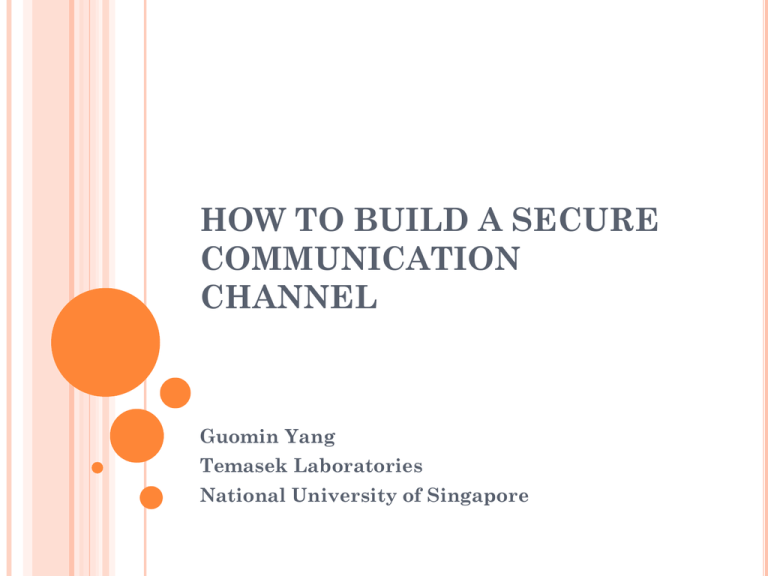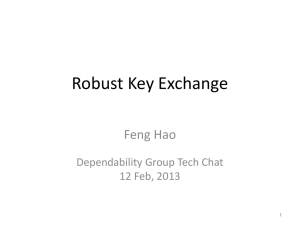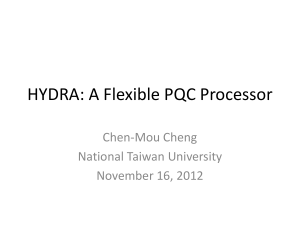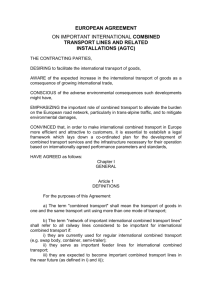Slides
advertisement

HOW TO BUILD A SECURE
COMMUNICATION
CHANNEL
Guomin Yang
Temasek Laboratories
National University of Singapore
AUTHENTICATED KEY EXCHANGE (AKE)
msg 1
msg 2
msg 3
Alice
K
Security Goals
Mutual Authentication
Secure Key Establishment
User Anonymity (optional)
Bob
K
DIFFIE-HELLMAN KEY EXCHANGE
X = gx
Y = gy
KA = Yx = gxy
Diffie-Hellman Assumption:
KB = Xy = gxy
Given gx and gy, it is computationally infeasible to
compute gxy.
What if the adversary can modify the messages?
MAN-IN-THE-MIDDLE ATTACK
X = gx
Y’ = gy’
KA = Y’x = gxy’
X’ = gx’
Y = gy
KB = X’y = gx’y
The adversary is able to derive both KA and KB
E(KA, m)
E(KB, m)
Outline
Security Model and Definition
Two-party AKE
ISO/IEC
SIGMA
(H)MQV
AKE under Bad Randomness
Secure Roaming
GSM/3GPP
Universal AKE
Other AKE Protocols
SECURITY MODEL AND DEFINITION
Adversarial Game
The adversary:
controls all the communications
schedules all the sessions
Adversarial Game
Each party can have multiple and concurrent sessions
Adversarial Game
Additional Queries
Session key reveal
Corruption
Test
Session freshness
No session key reveal
No Corruption before
session terminates
Adv(A) = Pr [A guesses b correctly] – 1/2
Test session must be fresh
An Authenticated Key Exchange Protocol is Secure if Adv(A) is
negligible for any PPT adversary A.
TWO-PARTY AKE PROTOCOLS
A “BAD” SIG-DH PROTOCOL
Alice
Idea: use digital signature to do authentication
Secure?
Eve replaces the last message with
Bob
ISO/IEC IS 9798-3
Alice
Bob
Provably Secure (Canetti-Krawczyk Eurocrypt’01)
Forward Secrecy
No User Anonymity
SIGMA
Alice
Bob
Basis of IKE (RFC 2409) and IKEv2 (RFC 4306)
Digital Signature: DSA
MAC: HMAC
Provably secure (Canetti-Krawczyk Crypto’02)
User Anonymity
MQV (IEEE P1363)
PKA = ga
PKB = gb
Alice
Bob
d = 2l+(X mod 2l)
σA = (Y· PKBe)x+da = g(x+da)(y+eb)
KA = H(σA)
e = 2l+(Y mod 2l)
σB = (X· PKAd)y+eb = g(x+da)(y+eb)
KB = H(σB)
Implicit Authentication
Explicit Authentication: Use MAC
KALISKI’S ATTACK
PKA = ga
PKM = gc
A, B, X = gx
B, A, Y
PKB = gb
M, B, Z
B, M, Y = gy
randomly choose u, set d = 2l+(X mod 2l),
Z = (X· PKAd · g-u), h = 2l+(Z mod 2l), c = u/h
σA = (Y· PKBe)x+da = g(x+da)(y+eb)
KA = H(σA)
σB = (Z· PKMh)y+eb = g(x+da)(y+eb)
KB = H(σB)
HMQV
PKA = ga
PKB = gb
d = G(X, B)
σA = (Y· PKBe)x+da = g(x+da)(y+eb)
KA = H(σA)
e = G(Y,A)
σB = (X· PKAd)y+eb = g(x+da)(y+eb)
KB = H(σB)
Provably Secure (Krawczyk Crypto’05)
Additional features:
resilience to the leakage of DH exponents
no group membership testing on X or Y
AKE UNDER BAD RANDOMNESS
Case 1: Reset Attacks
EXAMPLE: SIGMA
Alice
Bob
Reset Attack (FC’11):
Virtual Machine: snapshot and revert/reset function
Reset: randomness reuse
DSA: randomness reuse signing key disclosure
DSA
Param: a large prime p, a prime divisor q of (p-1), g =
h(p-1)/q mod p for arbitrary 1 < h < p-1.
SignKey: 0 < x < q
PK: gx mod p
Sign:
0<k<q
r = (gk mod p) mod q
s = (k−1(H(m) + xr)) mod q
Return (r, s)
Reset attack: the same k is used
s1 = (k−1(H(m1) + xr)) mod q
s2 = (k−1(H(m2) + xr)) mod q
s1 / s2 = (H(m1) + xr) / (H(m2) + xr) mod q
x = (H(m1)s1−1 – H(m2)s2−1) / (rs2−1 – rs1−1) mod q
EXAMPLE: HMQV
PKA = ga
PKB = gb
d = G(X, B)
σA = (Y· PKBe)x+da = g(x+da)(y+eb)
KA = H(σA)
e = G(Y,A)
σB = (X· PKAd)y+eb = g(x+da)(y+eb)
KB = H(σB)
Reset Attack (Menezes and Ustaoglu, IJACT)
Assumption: the HMQV protocol is implemented in a
subgroup (with prime order q) of Zp*, and (p-1)/q
has several small (e.g. less than 240) pairwise
relatively prime factors t1, t2, ..., tn such that t1·
t2··· tn > q.
EXAMPLE: HMQV
PKA = ga
PKB = gb
d = G(X, B)
σA = (Y· PKBe)x+da = g(x+da)(y+eb)
KA = H(σA)
e = G(Y,A)
σB = (X· PKAd)y+eb = g(x+da)(y+eb)
KB = H(σB)
Reset Attack (Menezes and Ustaoglu, IJACT)
The adversary corrupts Bob and obtains b
After receiving (A,B,X) from Alice, the adversary selects Y of order t 1,
and sends (B,A,Y) to Alice
Alice computes
σA = (Y· PKBe)x+da = Yx+da· (PKBe)x+da = Yx+da · (X· PKAd)be, KA = H(σA)
The adversary reveals KA, and iteratively computes K’ = H(Yc1 · (X·
PKAd)be) for c1 = 0, 1, 2, … until K’ = KA. Then c1 = x + da mod t1
EXAMPLE: HMQV
PKA = ga
PKB = gb
d = G(X, B)
σA = (Y· PKBe)x+da = g(x+da)(y+eb)
KA = H(σA)
e = G(Y,A)
σB = (X· PKAd)y+eb = g(x+da)(y+eb)
KB = H(σB)
Reset Attack (Menezes and Ustaoglu, IJACT)
The adversary resets A, and repeats the above process for
t2,··· ,tn and obtains ci = x + da mod ti. Then the adversary
computes (x+da mod q) by CRT.
The adversary corrupts another party P, and repeats the
above attack to get (x+d’a mod q).
Given (x+da mod q) and (x+d’a mod q), the adversary
computes a.
SIGMA WITH DETERMINISTIC DSA
Alice
Countermeasure (FC’11)
Deterministic DSA
SignKey’ = (SignKey, K)
Randomness = PRF(K, m) for message m
Preserves EUF-CMA security
Bob
EXAMPLE: HMQV
PKA = ga
PKB = gb
d = G(X, B)
σA = (Y· PKBe)x+da = g(x+da)(y+eb)
KA = H(σA)
e = G(Y,A)
σB = (X· PKAd)y+eb = g(x+da)(y+eb)
KB = H(σB)
Open problem: is HMQV resettably secure if group
membership test on X and Y is compulsory?
AKE UNDER BAD RANDOMNESS
Case 2: Adversary-Generated Randomness
ASSUMPTION
The long-term key is secure
(PKA,SKA)
(PKB,SKB)
msg 1
10110…
AKE Algo
msg 2
msg 3
AKE Algo
···
Reject, ⊥
or
Accept, K
Reject, ⊥
or
Accept, K
00110…
EXAMPLE: SIGMA WITH DETERMINISTIC DSA
Alice
Bob
The adversary controls the DH exponents x and y
the adversary controls the DH key gxy
Countermeasures?
To use deterministic DSA, the long-term key contains a
PRF key K
By the assumption, K is unknown to the adversary
Derive x’ = PRFK(x), and use x’ as the DH exponent
GENERIC TRANSFORMATION
Always include a PRF key K in the long-term
key, and use Rand’ = PRFK(Rand) as the
randomness for the AKE protocol
Theorem (FC’11): if an AKE protocol is secure in
Case 1, then the new protocol derived using the
above transformation is also secure in Case 2.
Additional notes:
Forward secrecy: possible in Case 1, but not in Case 2
The converted protocol may lose forward secrecy in
Case 1
To preserve forward secrecy in Case 1,
{K, PRFK(Rand)} ≈ {K, U}.
PRF must be a Randomness Extractor as well
Candidate for PRF: HMAC
SECURE ROAMING PROTOCOLS
SECURE ROAMING
Roaming
WLAN
Telecommunication
ATM/Credit Card
Home Server
(H)
Internet
A
Foreign Server
(V)
A
……
B
SECURE ROAMING
GSM
3GPP: Server Authentication
SECURE ROAMING
Deposit-case Attacks (IEEE TWC’07)
SECURE ROAMING
Deposit-case Attacks (IEEE TWC’07)
Attacks against other protocols: more complicated
SECURE ROAMING
Universal AKE Protocols (IEEE
TWC’10)
Idea: ID-based Cryptography
Home server = Key Generation Center
User Authentication: Public Key of the
Home Server + Mobile User Identity
Advantages:
Home Server
Foreign server does not need to contact
home server of a roaming user
Foreign server can use the same protocol
and signaling flows to authenticate both
local and foreign clients
Tools:
Identity-based Signature
Heterogeneous Signcryption (Comp. J.’11)
SKA
A
Foreign Server
SKA
A
B
SECURE ROAMING
Heterogeneous Signcryption (Comp. J.’11)
Identity-Based Signature + Conventional PKE
Avoid pairing operation
One-pass Universal AKE protocol
OTHER AKE PROTOCOLS
MULTI-FACTOR AKE PROTOCOLS (JCSS’08)
msg 1
msg 2
msg 3
s#2j!5 +
+
Something you know
Something you have
Something you are
……
GROUP AKE PROTOCOLS (CANS’10)
Security Requirements
Authentication
Session Key Secrecy
Insider Security
Forward/Backward Security
Contributiveness
Robustness
THANK YOU
EMAIL: TSLYG@NUS.EDU.SG









